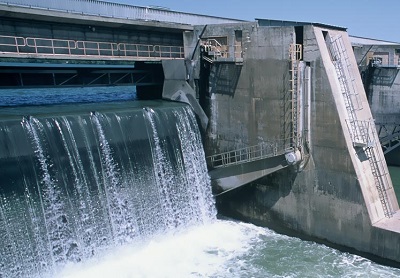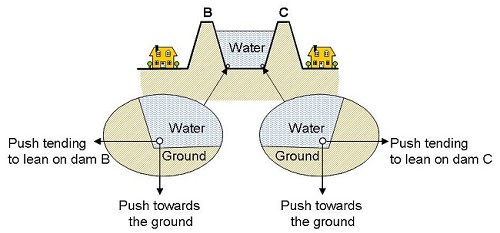In open air tanks, only the height of the liquid above the measuring point conditions the pressure.
Thus, the exerted pressures on the bottom of the three tanks below are identical, because the heights (h) of the liquid are the same:
hA = hB = hC so pA = pB = pC


The weight of water in the three tanks is different, but the surface areas are
too.

- The large weight of water B corresponds to a large surface area SB,
- The medium weight of water A corresponds to the medium surface area SA,
- The small weight of water C corresponds to a small surface area SC , etc.
Question
Why do the dams A, B, & C below need a larger thickness at the base than at the top ?

At the foot of dams, the pressure due to the water increases in importance in relation to the height of the water. Dams have a very great thickness at the base to withstand the very high pressures.
The pressures ‘push’ in all directions. The pressures tend to ‘lean’ on the dams.
To prevent the pressure becoming excessive, the dam management must ensure that the height of the stored water does not become too much.
The pressure exerted on the top of the dams is considerably less; thus the tops are much less thick.
Question
Why is dam A, which support a very large mass of water, the same thickness as dam B & C, which store much less water

It is not the quantity of stored water that counts but its height.
The water height is identical in both reservoirs.
The dams A, B, & C must therefore have the same resistance.
Pressures have no ”sense of direction”. They push in all directions and especially onto load-bearing surfaces
Question
Which surface “absorbs” the most pressure from the enormous mass of water to the left of dam ‘A’ below ?

The majority of the pressure due to the water stored by dam A is on the bottom of the reservoir.
Question
Are the pressures on the bottom of the vessels A and C, below, different? How is this possible ?

The pressures on the bottom of the two vessels A and C are identical because the height of the water (h) is the same.
The inclined sides of vessel C “absorb” the pressures from the height of water above.
